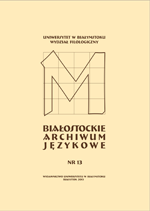Модель функций языка и речи для дисциплин, изучающих употребление языка
Language and speech functions model for academic disciplines studying use of language
Author(s): Władimir ZaikaSubject(s): Language and Literature Studies, Theoretical Linguistics, Applied Linguistics
Published by: Wydawnictwo Uniwersytetu w Białymstoku
Keywords: language functions; speech functions; coordinative functions; non-coordinative functions; communicative; appealing; emotive; phatic; magic; identifying; aesthetic functions
Summary/Abstract: Language functions are considered as means 1) to provide communication (speech) and 2) to be a basis for knowledge and thoughts (gnostic function). Speech functions are understood as attitudes of an utterance to components of a communicative situation. Speech functions are divided into coordinative ones, when an utterance coordinates an interlocutor’s behavior (representative, appealing and emotive functions) and non-coordinative functions, when an utterance does not coordinate an interlocutor’s behavior (phatic, aesthetic, magic functions). The model can be applied in teaching stylistics, rhetoric and speech culture.Funkcje języka to zapewnienie komunikacji (mowa) i podstawa (źródło) wiedzy i myśli (gnostyczna). Przez funkcje mowy rozumiany jest stosunek wypowiedzi do elementów sytuacji komunikacyjnej. Wyróżnia się koordynacyjne (reprezentatywna, nakłaniająca, emotywna) i niekoordynacyjne (fatyczna, estetyczna, magiczna) funkcje mowy. Przedstawiony model może być wykorzystywany w procesie nauczania w dyscyplinach, których przedmiotem jest wykorzystanie języka: stylistyka, retoryka, kultura języka.
Journal: Białostockie Archiwum Językowe
- Issue Year: 2013
- Issue No: 13
- Page Range: 415-430
- Page Count: 16
- Language: Russian

